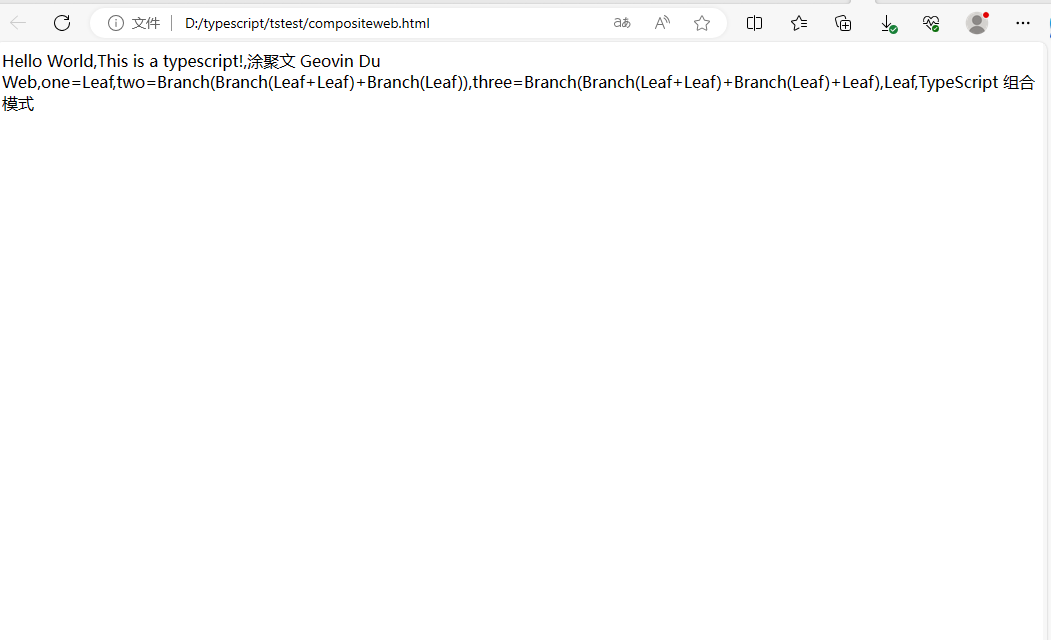/**
* Composite Pattern 组合是一种结构型设计模式, 你可以使用它将对象组合成树状结构, 并且能像使用独立对象一样使用它们。
* https://refactoringguru.cn/design-patterns/composite/typescript/example#lang-features
* The base Component class declares common operations for both simple and
* complex objects of a composition.
*
*
*/
abstract class DuComponent {
protected parent!: DuComponent | null;
/**
* Optionally, the base Component can declare an interface for setting and
* accessing a parent of the component in a tree structure. It can also
* provide some default implementation for these methods.
*/
public setParent(parent: DuComponent | null) {
this.parent = parent;
}
/**
*
*/
public getParent(): DuComponent | null {
return this.parent;
}
/**
* In some cases, it would be beneficial to define the child-management
* operations right in the base Component class. This way, you won't need to
* expose any concrete component classes to the client code, even during the
* object tree assembly. The downside is that these methods will be empty
* for the leaf-level components.
*/
public add(component: DuComponent): void { }
/**
*
* @param component
*/
public remove(component: DuComponent): void { }
/**
* You can provide a method that lets the client code figure out whether a
* component can bear children.
*/
public isComposite(): boolean {
return false;
}
/**
* The base Component may implement some default behavior or leave it to
* concrete classes (by declaring the method containing the behavior as
* "abstract").
*/
public abstract operation(): string;
}
/**
* The Leaf class represents the end objects of a composition. A leaf can't have
* any children.
*
* Usually, it's the Leaf objects that do the actual work, whereas Composite
* objects only delegate to their sub-components.
*/
class Leaf extends DuComponent {
public operation(): string {
return 'Leaf';
}
}
/**
* The Composite class represents the complex components that may have children.
* Usually, the Composite objects delegate the actual work to their children and
* then "sum-up" the result.
*/
class Composite extends DuComponent {
protected children: DuComponent[] = [];
/**
* A composite object can add or remove other components (both simple or
* complex) to or from its child list.
*/
public add(component: DuComponent): void {
this.children.push(component);
component.setParent(this);
}
/**
*
* @param component
*/
public remove(component: DuComponent): void {
const componentIndex = this.children.indexOf(component);
this.children.splice(componentIndex, 1);
component.setParent(null);
}
/**
*
*/
public isComposite(): boolean {
return true;
}
/**
* The Composite executes its primary logic in a particular way. It
* traverses recursively through all its children, collecting and summing
* their results. Since the composite's children pass these calls to their
* children and so forth, the whole object tree is traversed as a result.
*/
public operation(): string {
const results = [];
for (const child of this.children) {
results.push(child.operation());
}
return `Branch(${results.join('+')})`;
}
}
/**
* The client code works with all of the components via the base interface.
*/
function clientCodeCompostite(component: DuComponent) {
// ...
let str="";
console.log(`RESULT: ${component.operation()}`);
str=str+component.operation();
return str;
// ...
}
/**
* This way the client code can support the simple leaf components...
*/
let strCom="";
const simple = new Leaf();
console.log('Client: I\'ve got a simple component:');
strCom=clientCodeCompostite(simple);
console.log('');
/**
* ...as well as the complex composites.
*/
const tree = new Composite();
const branch1 = new Composite();
branch1.add(new Leaf());
branch1.add(new Leaf());
const branch2 = new Composite();
branch2.add(new Leaf());
tree.add(branch1);
tree.add(branch2);
console.log('Client: Now I\'ve got a composite tree:');
let strCom1=clientCodeCompostite(tree);
console.log('');
/**
* Thanks to the fact that the child-management operations are declared in the
* base Component class, the client code can work with any component, simple or
* complex, without depending on their concrete classes.
*/
function clientCodeCompostite2(component1: DuComponent, component2: DuComponent) {
// ...
let str="";
if (component1.isComposite()) {
component1.add(component2);
}
console.log(`RESULT: ${component1.operation()}`);
return str=component1.operation()+","+component2.operation();
}
console.log('Client: I don\'t need to check the components classes even when managing the tree:');
let strCom2=clientCodeCompostite2(tree, simple);
let messageComposite: string = 'Hello World,This is a typescript!,涂聚文 Geovin Du Web';
document.body.innerHTML = messageComposite+",one="+strCom+",two="+strCom1+",three="+strCom2+",TypeScript 组合模式"
调用:
<!doctype html>
<html lang="en">
<head>
<meta charset="UTF-8">
<meta name="viewport"
content="width=device-width, user-scalable=no, initial-scale=1.0, maximum-scale=1.0, minimum-scale=1.0">
<meta http-equiv="X-UA-Compatible" content="ie=edge">
<head><title>TypeScript:桥接模式</title>
<meta name="Description" content="geovindu,涂聚文,Geovin Du"/>
<meta name="Keywords" content="geovindu,涂聚文,Geovin Du"/>
<meta name="author" content="geovindu,涂聚文,Geovin Du"/>
</head>
<body>
<script src="dist/Compositets.js"></script>
</body>
</html>
输出:
